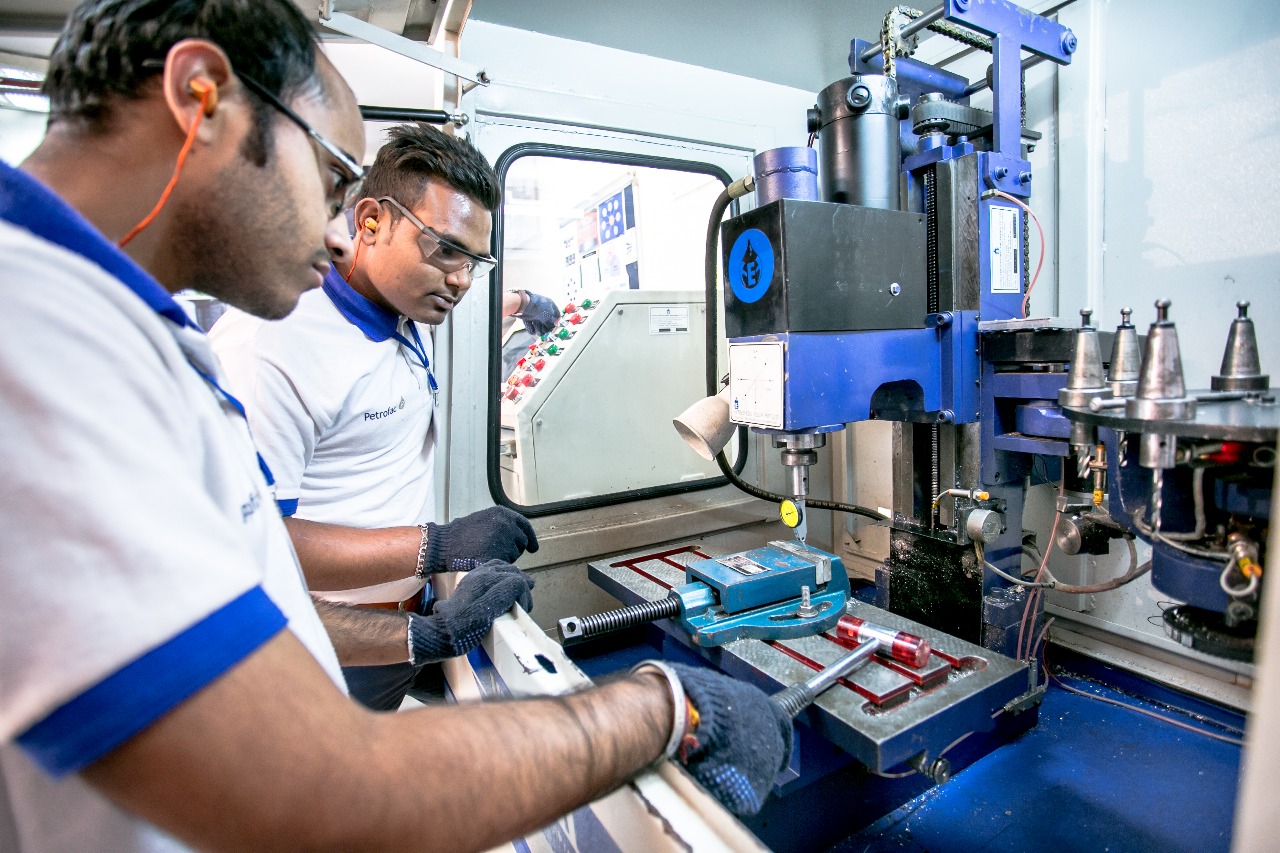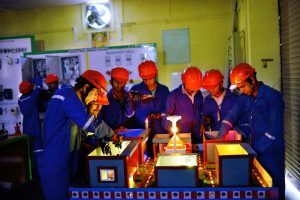
– Ketul Acharya
For a country like India, where approximately 65% of the population is below 35 years of age, the human resources component is a vital component of its economy. It is because of this reason that tapping the same through gainful employment is crucial, which is why adequate education and skilling are essential.

Trainees learning installation of a Solar panel under Suryamitra programmes, National Institute of Solar Energy, Ministry of New & Renewable Energy.
India is on the verge of a digital revolution, which is all set to impact diverse sectors, creating a new set of jobs, and rendering some existing ones obsolete. The ‘digital economy’ will demand very different skills, though some real economy vocations such as plumbing or carpentry will survive. This dynamic trend could be attributed to the beginning of a ‘Fourth Industrial Revolution’. According to a PwC report, Artificial Intelligence or AI will contribute as much as $15.7 trillion to the world economy by 2030. Given India’s strength in technology, favorable demographics and structural advantages in the availability of advanced data, India can be an AI pioneer. AI has the potential to add $957 billion to India’s economy by 2035, lifting it by 15% (Accenture report). India’s data diversity is a big draw for global AI implementers. AI can be a game changer in government, where “scale” and “quality” need to be addressed simultaneously. On the flip side, and as per a McKinsey report, an estimated 400-800 million people around the globe could be displaced by automation, and will, hence, need to find new jobs by 2030, for which they will require new skills. There will be considerable need for re-skilling and training. While the impending change holds great promise, the patterns of consumption, production, and employment created by it also pose major challenges requiring proactive adaptation by corporations, governments and individuals. As industries adjust, most occupations are undergoing a fundamental transformation. While some jobs are threatened by redundancy and others grow rapidly, existing jobs are also going through a change in skill sets required to execute them. By 2020, according to the World Economic Forum, 4% of all jobs will have a core requirement for physical abilities such as physical strength or dexterity; 36% of all jobs, across all industries, are expected to require complex problem-solving as one of their core skills.

The capital goods industry employs 1.4 million people and is estimated to employ 3.8 million by 2020. This indicates good job growth for professionals such as Fitter – Fabricators in this sector.
The quantitative, as well as qualitative skill gaps, can further widen going forward if there are no or limited efforts towards addressing the key supply related issues. As per the skill gap study conducted by the National Skill Development Cooperation (NSDC) over 2010 – 2014, there is an additional net requirement of 109.73 million skilled manpower by 2022 across 24 key sectors. As India strengthens its base as a knowledge economy, there would be additional requirements to the highly skilled workforce in sectors like financial services, IT/ITeS, Biotechnology, Health-care, and Pharmaceuticals. Further, with value-added industries being given a policy push under the ‘Make in India’ initiative, the highly skilled workforce would also be required in high-end industries.

Welding trainees are equipped to weld everything we see around us like buildings, bridges, flyover, cars, locomotives & coaches, ships, airplanes, general machinery, consumer durables and defense equipment.
According to a joint report by NASSCOM and EY, exponential technologies in advanced markets are expected to improve productivity by 15-20% in the next five years, while 60-65% of the Indian workforce in the IT-BPM sector would be deployed in jobs that have radically changed skill sets, followed by 55-60% in BFSI and 50-55% in the automotive sector. In the organized manufacturing and service sector, employment is expected to increase from the current 38 million to 46-48 million by 2022. All the new forms of employment are expected to add a further 20-25% to the workforce of the current “organized” sector in 2022. This would increase the share of the organized sector in the overall economy to 10% from the current 8%. The new forms of employment would include contract employees in the infrastructure sector, micro-entrepreneurs supported by MUDRA schemes, employer-entrepreneurs in technology-enabled employment models, freelance workers on online platform models, “Uber” workers, SME and artisan entrepreneurs on e-commerce platforms, delivery workers and service providers in the e-commerce ecosystem and employees in tech start-ups.

The rising and disposable incomes in urban societies have given a huge impetus to the food and beverage industry providing large opportunities to professionals in this field.
Encapsulated in a nutshell, the combined effect of the oncoming ‘fourth industrial revolution’ (maybe overhyped or real), weakening economy and reducing jobs force us to start thinking of new models and better programs, which may be named ‘New Skills’. The core skills requirements for many industries will include: content skills, which include ICT literacy and active learning; cognitive abilities such as creativity and mathematical reasoning, and process skills such as active listening and critical thinking; social skills including persuasion, Emotional Intelligence and teaching others, will also be in higher demand. Positions likely to be in demand in the coming years include data scientists, retail planners, product managers and digital marketers.
Countries, across the world, are gradually shifting gears to accommodate this paradigm shift, which is enforcing itself over the passage of time. For example, SkillsFuture, a national movement to provide Singaporeans with the opportunities to develop their fullest potential throughout life, regardless of their starting points, is one such initiative undertaken by the Government of Singapore. Keeping the above in mind, the four key areas of focus under the Skills Future Council would be: helping individuals make well-informed choices in education, training, and careers; developing an integrated, high-quality system of education and training that responds to constantly evolving industry needs; promoting employer recognition and career development based on skills and mastery, and fostering a culture that supports and celebrates lifelong learning. This initiative helps citizens acquire and upgrade their skills, throughout their career, by offering long and short programs in an offline and online mode of study. These courses are offered at the at the school level, at the workplace, and after a few years of working (skills upgradation). Another unique training model started in America, called Andela, blends personalized instruction, supports self-study and hands-on experience while building real products. Similar to these, there are many more examples.

CNC Technicians trained as machinists with additional skills in programming, setup and operating computer-driven machine tools for high-tech products including computers, aircraft, and medical devices.
The focus has to shift to super specialization streams (Applications Developer, Data Analytics, Artificial Intelligence, Robotics etc.), building on existing trades by upgrading them (electrician +, farmer +), and new avenues such as e-retails, logistics, healthcare of senior citizens, among others. One may ask, what does, for example, the term ‘electrician+’ even mean? The answer to this is a ‘future-proof electrician’; and what will this new age electrician do? What does he/she have to be trained for/equipped with? Can we bring in AR/VR/IOT technology in existing curriculum to upgrade it? For this, a study of the ‘evolution’ of the job role in the next 10 years is vital. Based on this study, trainings have to be adapted, enhanced and streamlined.

Training electricians of the future to know how to integrate different systems from different providers together to make sure that they can talk and understand one another.
An example, further to the above, is the following: Android, which is backed by Google Inc., and is the fastest growing open source mobile device platform, offers a powerful application development framework (C++/Java and XML) and open access to APIs to build richer mobile applications ranging from enhancing the user experience to productivity and entertainment. Hence, ideally speaking, the training content to be imparted should focus on application level APIs to develop user and data-centric mobile applications and utilities on the Android platform. The programme will include Android application development including working with graphics, multimedia, connectivity, and location-based services. In addition, the learner will need to learn how to debug, deploy and test mobile applications. Another example: cloud computing; with most global organizations switching to cloud computing technologies, there was never a better time to kick-start a career in cloud computing. 42% of IT decision makers increased their spending on cloud computing in 2015. The course should allow scope for improving the skills to handle cloud applications and services, including learning about AWS, Amazon EC2m EBS, Networking Services and Management Tools. Yet another example is training in the field of DevOps; this could be designed to certify students by providing hands-on experience on DevOps tools and teaching best practices about Continuous Development, Continuous Testing, Configuration Management, including Continuous Integration and Continuous Deployment and finally Continuous Monitoring of the software throughout its development life cycle. Many of the existing working professionals like System Admins, Developers, Testers, Solution Architects, Release Engineers, Cloud Professionals can opt for this course.

A trained General Duty Assistant can decrease the workload and also add value to the value chain of the healthcare delivery system by handling some of the major functions involving patient care.
So, the above can be summarized succinctly as the following: there exists an ever-growing need to learn, unlearn and relearn skills, thanks to dynamic influences impacting global economies. For this, the need to understand emerging trends, study their possible futuristic evolution, and thereby determine possible job trends or emerging skill sets is critical to the sustenance of healthy economies. Easier said than done; however, at least a beginning of sorts has been made, which is being nurtured into some sort of organized preparedness – vital for the survival of gainful employment, and the power of human resources, that always was, and, hopefully, will always be.

Banking programmes are designed to aid a smooth entry for graduates into the Branch Banking Executive jobs. The successful candidates can become a part of the bank with a minimum turnaround time.
Ketul Acharya is the Chief Operating Officer and Group Head – Skills Initiatives, IL&FS Skills Development Corporation Ltd. (ketul.acharya@ilfsindia.com)



Sorry, the comment form is closed at this time.